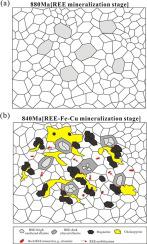当前位置:
X-MOL 学术
›
Ore Geol. Rev.
›
论文详情
Our official English website, www.x-mol.net, welcomes your feedback! (Note: you will need to create a separate account there.)
Two episodes of REEs mineralization at the Sin Quyen IOCG deposit, NW Vietnam
Ore Geology Reviews ( IF 3.3 ) Pub Date : 2020-10-01 , DOI: 10.1016/j.oregeorev.2020.103676 Xuan Dac Ngo , Xin-Fu Zhao , Thanh Hai Tran , Xiao-Dong Deng , Jian-Wei Li
Ore Geology Reviews ( IF 3.3 ) Pub Date : 2020-10-01 , DOI: 10.1016/j.oregeorev.2020.103676 Xuan Dac Ngo , Xin-Fu Zhao , Thanh Hai Tran , Xiao-Dong Deng , Jian-Wei Li

|
Abstract The Sin Quyen iron oxide-copper–gold (IOCG) deposit in northwestern Vietnam contains a proven reserve of 52.8 Mt ores at 14% Fe, 0.91% Cu, 0.7% REEs (rare earth elements), and 0.44 g/t Au. REEs mineralization is hosted within Ca-silicate alteration zone and associated with Fe-Cu ore bodies in the gneiss, mica schist, and marble of the Upper Sin Quyen Formation. Two mineralization episodes are identified based on the field and petrographic relations. The first episode includes sodic alteration (stage I-1), calcic alteration and associated REE mineralization (stage I-2), and localized K-Fe alteration (stage I-3). The second episode is main stage mineralization and contains four main stages of alteration: pre-ore Na alteration (stage II-1), Ca-Fe alteration and the associated Fe-REE mineralization (stage II-2), K-Fe alteration and associated Cu-Au mineralization (stage II-3), and the final carbonate stage of quartz-carbonate veins (stage II-4) crosscutting the above-mentioned alteration phases and ores. Primary allanite and type 1 titanite (Tnt-1) from episode 1 yield weighted mean 206Pb/238U ages of 882 ± 3 Ma and 881 ± 8 Ma (2σ), respectively, which are interpreted as the timing of REE mineralization in episode 1. Secondary allanite and type 2 titanite (Tnt-2) associated with iron-oxide and Cu-Au ores, however, have U-Pb ages of 840 ± 7 Ma and 838 ± 5 Ma (2σ), respectively. These ages are hence considered to represent the timing of polymetallic IOCG mineralization in episode 2. ~880 Ma titanite grains have eNd(t) values ranging from −7.00 to −5.43, which are intermediate between the Neoproterozoic felsic intrusions and ore-hosting meta-sedimentary rocks in the region and likely reflect interaction between magmatic fluids and ore-hosting rocks. In contrast, ~840 Ma titanite have eNd(t) values ranging from −4.31 to −1.97, similar to those of the Neoproterozoic felsic intrusions, indicating a possible magmatic fluid source for the episode II IOCG mineralization. Multiple episodes of mineralization at Sin Quyen were likely formed during the prolonged tectonothermal events related to backarc extension during the Neoproterozoic subduction along the western margin of the Yangtze Block.
中文翻译:

越南西北部 Sin Quyen IOCG 矿床的两期 REE 矿化
摘要 越南西北部的 Sin Quyen 氧化铁-铜-金 (IOCG) 矿床已探明储量 52.8 Mt,含 14% Fe、0.91% Cu、0.7% REE(稀土元素)和 0.44 g/t Au。REEs 矿化位于钙硅酸盐蚀变带内,与上新群组片麻岩、云母片岩和大理岩中的铁铜矿体伴生。根据油田和岩相关系确定了两个矿化事件。第一阶段包括钠蚀变(I-1 阶段)、钙蚀变和相关 REE 矿化(I-2 阶段)和局部 K-Fe 蚀变(I-3 阶段)。第二阶段是主要矿化阶段,包含四个主要蚀变阶段:矿前钠蚀变(II-1 阶段)、Ca-Fe 蚀变和相关的 Fe-REE 矿化(II-2 阶段),K-Fe蚀变和伴生的Cu-Au矿化(II-3期),以及石英-碳酸盐脉的最终碳酸盐阶段(II-4期)横切上述蚀变相和矿石。来自第 1 集的原生花岗岩和 1 型钛钛矿 (Tnt-1) 产生的加权平均 206Pb/238U 年龄分别为 882 ± 3 Ma 和 881 ± 8 Ma (2σ),这被解释为第 1 集稀土矿化的时间。然而,与氧化铁和铜金矿石伴生的次生花岗岩和 2 型钛石 (Tnt-2) 的 U-Pb 年龄分别为 840 ± 7 Ma 和 838 ± 5 Ma (2σ)。因此,这些年龄被认为代表了第 2 集中多金属 IOCG 矿化的时间。~880 Ma 钛铁矿颗粒的 eNd(t) 值范围从 -7.00 到 -5.43,它们介于该地区的新元古代长英质侵入体和赋矿变质沉积岩之间,可能反映了岩浆流体和赋矿岩之间的相互作用。相比之下,~840 Ma 钛铁矿的 eNd(t) 值范围从 -4.31 到 -1.97,类似于新元古代长英质侵入体,表明可能是第二集 IOCG 矿化的岩浆流体来源。在新元古代沿扬子地块西缘俯冲期间与弧后伸展相关的长期构造热事件中,可能形成了新泉的多次矿化事件。类似于新元古代长英质侵入体,表明可能是第二集 IOCG 矿化的岩浆流体来源。在新元古代沿扬子地块西缘俯冲期间与弧后伸展相关的长期构造热事件中,可能形成了新泉的多次矿化事件。类似于新元古代长英质侵入体,表明可能是第二集 IOCG 矿化的岩浆流体来源。在新元古代沿扬子地块西缘俯冲期间与弧后伸展相关的长期构造热事件中,可能形成了新泉的多次矿化事件。
更新日期:2020-10-01
中文翻译:

越南西北部 Sin Quyen IOCG 矿床的两期 REE 矿化
摘要 越南西北部的 Sin Quyen 氧化铁-铜-金 (IOCG) 矿床已探明储量 52.8 Mt,含 14% Fe、0.91% Cu、0.7% REE(稀土元素)和 0.44 g/t Au。REEs 矿化位于钙硅酸盐蚀变带内,与上新群组片麻岩、云母片岩和大理岩中的铁铜矿体伴生。根据油田和岩相关系确定了两个矿化事件。第一阶段包括钠蚀变(I-1 阶段)、钙蚀变和相关 REE 矿化(I-2 阶段)和局部 K-Fe 蚀变(I-3 阶段)。第二阶段是主要矿化阶段,包含四个主要蚀变阶段:矿前钠蚀变(II-1 阶段)、Ca-Fe 蚀变和相关的 Fe-REE 矿化(II-2 阶段),K-Fe蚀变和伴生的Cu-Au矿化(II-3期),以及石英-碳酸盐脉的最终碳酸盐阶段(II-4期)横切上述蚀变相和矿石。来自第 1 集的原生花岗岩和 1 型钛钛矿 (Tnt-1) 产生的加权平均 206Pb/238U 年龄分别为 882 ± 3 Ma 和 881 ± 8 Ma (2σ),这被解释为第 1 集稀土矿化的时间。然而,与氧化铁和铜金矿石伴生的次生花岗岩和 2 型钛石 (Tnt-2) 的 U-Pb 年龄分别为 840 ± 7 Ma 和 838 ± 5 Ma (2σ)。因此,这些年龄被认为代表了第 2 集中多金属 IOCG 矿化的时间。~880 Ma 钛铁矿颗粒的 eNd(t) 值范围从 -7.00 到 -5.43,它们介于该地区的新元古代长英质侵入体和赋矿变质沉积岩之间,可能反映了岩浆流体和赋矿岩之间的相互作用。相比之下,~840 Ma 钛铁矿的 eNd(t) 值范围从 -4.31 到 -1.97,类似于新元古代长英质侵入体,表明可能是第二集 IOCG 矿化的岩浆流体来源。在新元古代沿扬子地块西缘俯冲期间与弧后伸展相关的长期构造热事件中,可能形成了新泉的多次矿化事件。类似于新元古代长英质侵入体,表明可能是第二集 IOCG 矿化的岩浆流体来源。在新元古代沿扬子地块西缘俯冲期间与弧后伸展相关的长期构造热事件中,可能形成了新泉的多次矿化事件。类似于新元古代长英质侵入体,表明可能是第二集 IOCG 矿化的岩浆流体来源。在新元古代沿扬子地块西缘俯冲期间与弧后伸展相关的长期构造热事件中,可能形成了新泉的多次矿化事件。



























 京公网安备 11010802027423号
京公网安备 11010802027423号